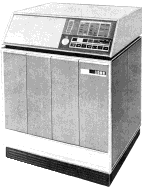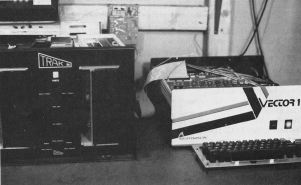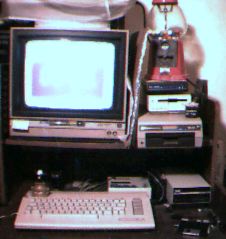Table of Contents
RO))$219029323
AT
0
ATDT12095551363
CONNECTED AT 300 BAUD
===================================
A Little Microcomputer BBS History
===================================
command:_
The picture at left is an IBM 1009 Data Transmission Unit from early 1960s, it is roughly the size of a washing machine and allowed IBM computers at that time (such as the IBM 1460) to communicate as fast as 300 characters per second (roughly 3000 baud, a tad better then a 2400 baud modem) over dedicated phone lines.
Anyone with more accurate information, please feel free to e-mail me about my inaccuracies, I would greatly appreciate it.
In the beginning
 Before microcomputers and mini-computers there were just 'computers,' large monstrous machines now seemingly huge and simple in design, back then were innovative, faster than people, and VERY expensive . These computers were very uncommon and only large corporations had them (many of those computers took up the space of a small house, and cost in hundreds of thousands if not millions of dollars). A common problem to these owners was: due the primitive operating systems and design it was best to leave these computers on 24 hours a day through all or most of the work week. During night hours and weekends the computers would run almost idle using energy and man-hours for maintenance. In order to off-set the costs some companies leased or rented time on their computers during these normally idle times. This gave smaller companies the chance to access the power of the computer at a mere fraction of the cost, this was called 'time-sharing' and access was usually via phone lines or dedicated leased phone lines.
Before microcomputers and mini-computers there were just 'computers,' large monstrous machines now seemingly huge and simple in design, back then were innovative, faster than people, and VERY expensive . These computers were very uncommon and only large corporations had them (many of those computers took up the space of a small house, and cost in hundreds of thousands if not millions of dollars). A common problem to these owners was: due the primitive operating systems and design it was best to leave these computers on 24 hours a day through all or most of the work week. During night hours and weekends the computers would run almost idle using energy and man-hours for maintenance. In order to off-set the costs some companies leased or rented time on their computers during these normally idle times. This gave smaller companies the chance to access the power of the computer at a mere fraction of the cost, this was called 'time-sharing' and access was usually via phone lines or dedicated leased phone lines.
As time passed many private users obtained terminals (usually old teletypes and the sort) and modems (not a small cost back then, well into the hundreds of dollars for a modem from 110 to 300 baud) and found the dial-up business time-share networks a great place to play games, write messages to one another, and explore the computers they connected to. There was a couple problems to this, (besides the usually long-distance phone bill) the the cost to access the mainly-business services (priced for other businesses not for individuals) and the hours you could connect. As 'user-membership' in the corporate networks improved time-share services followed, one of the first popular commercial business connections was CompuServe, the first public accessible network being 'The Source'.
Advent of the Microcomputer
Even to the average Joe the time-share network was still expensive with time limitations and hefty hourly access rates. Of course things were changing in the industry, electronics companies started to produce low-cost 'micro-processors' and electronics hobbyists started designing and selling hobby/home microcomputer systems based on them. The technology once only accessible to the rich companies was made affordable to the public. Many of the devices of the older machines were scaled down for a more consumer-level cost and design. Micro computers were in the hundreds to thousands now and modems were well under $1000 for 300 baud (there were also some electronics projects available to assist you in building your own microcomputer modem from scratch.)
Introducing the first microcomputer BBS - CBBS!
 CBBS circa 1980Microcomputer Bulletin Board's beginnings trace back first as a dial-up messase center, it was 1978 when Ward Christianson and Randy Suess in Chicago, Illinois, wrote CBBS (Community Bulletin Board System) an on-line message base for utilizing a common home microcomputer (Altair 8080 was the first computer I believe) and modem. Before that most people (who actually owned modems, which were very few) connected to those large computers in universities or the above mentioned private computer networks. From that point on BBSs became a place for many computer hobbyists of the day to exchange helpful tips, information about their machines, and an occasionally discussions. Many of the boards were ran by computer hobbyists, not to unlike ham radio operators, mostly paying all their expense out of their own pocket and giving fee access to their users. The first BBSs were little more than a message center with E-Mail and open discussions, if one wanted to share a program they had written with others it would be 'listed' in ASCII format in a message and then the receiver would either have to write it down, retype it, or if they had the know-how, code a program that would convert it into the computer's language directly. Later came X-Modem (also developed by Christenson and Suess), one of the first standard protocol for error-fee file/data exchange. Soon CBBS and other bulletin boards added upload/download libraries with with X-Modem support. Users could now 'download' and 'upload' files directly to/from the disk drives without the muss & fuss of retyping or conversion utilities. The big networks were still getting good business as they offer such things as multi-user on-line chat areas, huge download sections, and local call access in large cities via packet switched networking. As the BBS programmers got more creative other features were added such as G-File Areas (general text files, could also be from the pre-file transfer days.), pictures (some utilizing just ASCII characters and later some using the RLE image compression format (which was originally developed by CompuServe)), user voting booth, and hard coded on-line games.
CBBS circa 1980Microcomputer Bulletin Board's beginnings trace back first as a dial-up messase center, it was 1978 when Ward Christianson and Randy Suess in Chicago, Illinois, wrote CBBS (Community Bulletin Board System) an on-line message base for utilizing a common home microcomputer (Altair 8080 was the first computer I believe) and modem. Before that most people (who actually owned modems, which were very few) connected to those large computers in universities or the above mentioned private computer networks. From that point on BBSs became a place for many computer hobbyists of the day to exchange helpful tips, information about their machines, and an occasionally discussions. Many of the boards were ran by computer hobbyists, not to unlike ham radio operators, mostly paying all their expense out of their own pocket and giving fee access to their users. The first BBSs were little more than a message center with E-Mail and open discussions, if one wanted to share a program they had written with others it would be 'listed' in ASCII format in a message and then the receiver would either have to write it down, retype it, or if they had the know-how, code a program that would convert it into the computer's language directly. Later came X-Modem (also developed by Christenson and Suess), one of the first standard protocol for error-fee file/data exchange. Soon CBBS and other bulletin boards added upload/download libraries with with X-Modem support. Users could now 'download' and 'upload' files directly to/from the disk drives without the muss & fuss of retyping or conversion utilities. The big networks were still getting good business as they offer such things as multi-user on-line chat areas, huge download sections, and local call access in large cities via packet switched networking. As the BBS programmers got more creative other features were added such as G-File Areas (general text files, could also be from the pre-file transfer days.), pictures (some utilizing just ASCII characters and later some using the RLE image compression format (which was originally developed by CompuServe)), user voting booth, and hard coded on-line games.
As the microcomputer BBSs matured from a mishmash of sysop's home-brew systems to commercial products, expandability and important features were added, two of the most important were BBS networking, where the BBSs themselves could be programmed to call other BBSs automatically (running the right software) and exchange public messages, e-mail and an occasional file or two the software, which gave urban and remote rural BBSs increased diversity, the other, 'modular programming,' which meant the BBSs could be easily added-to or even modified by the sysops to meet the tastes/demands of sysop and/or BBS callership.
BBS's Golden Years 1980's
 The real heyday of BBS callership started in the early 80's as the prices and availability of microcomputer hardware and modems were dropping dramatically ($200-700 for a computer and under $100 for a simple 300 baud modem!), the technology was not as intimidating, also due to one film: War Games. The movie, War Games, starring Matthew Broderick as a young computer 'cracker' hacking into a defense department system via a modem and home computer and nearly starting World War III sparked the interest and imagination of people everywhere. Soon afterward there were thousands of people buying computers and logging onto BBSs and networks eager to feel the excitement of computer communications, some were looking to do mischief others to explore the possibilities. As much as it was bad, alot of it was good.
The real heyday of BBS callership started in the early 80's as the prices and availability of microcomputer hardware and modems were dropping dramatically ($200-700 for a computer and under $100 for a simple 300 baud modem!), the technology was not as intimidating, also due to one film: War Games. The movie, War Games, starring Matthew Broderick as a young computer 'cracker' hacking into a defense department system via a modem and home computer and nearly starting World War III sparked the interest and imagination of people everywhere. Soon afterward there were thousands of people buying computers and logging onto BBSs and networks eager to feel the excitement of computer communications, some were looking to do mischief others to explore the possibilities. As much as it was bad, alot of it was good.
Near the end of the 80s and into the early 90s there was another BBS boom, this time it was to 'cash-in' of the telecommunications boom, boards with thousands of dollars in hardware and software running programs as sophisticated (if not more) than the early networks offering multi-user access, chat areas, downloading, on-line games, etc. Many of those enterprising sysops made little or no money (usually lost money in the long run), only the lucky few with the right control and user base ever saw any profit.
Now: The Internet
Telecommunications changed dramatically when the old world-wide Military/Scientific Networks (MilNet and ArpaNet) were reworked into what is now known as the Internet and opened to commercial and public access. As community access increased and the internet software improved many that had called BBSs have moved on to 'the' global network. Most for-profit and many hobby BBSs disappeared in just a couple years as their callership dried up. There are still plenty of BBSs still out there but only a fraction of a few years back.
People don't get out as much as they do with all the in-home entertainment, and modems give the public a form of interaction that some who are homebound had been missing. Local BBSs are now more of a 'community' gathering as the internet and on-line services (with reduced rates, global reach and local-call accessibility) has drawn the attention of many modemers away. Some BBSs still offer those users without fancy equipment or connection (to the internet or on-line services) a chance to get on-line, and locals a sense of community.
BBSs have given some the ability to be unnoticed or more comfortable among others, when you are on-line no one knows whether you are male, female, disabled, of a different race, or what beliefs you have unless you make them known. Though with everything there are two sides, where it gives some equality it gives others anonymity to who they are (and in some circumstances, how old they are) or what their intentions may be. As with every change society is adapting and going through change to better handle this new 'cyber culture'.
